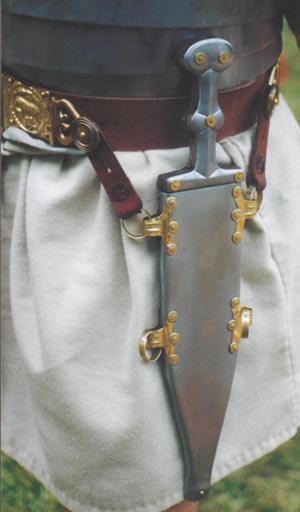Pugio
Like other items of legionary equipment, the dagger was undergoing some changes during the 1st Century AD. Generally, it had a large, leaf-shaped blade 7" to 11" long and 2" or more in width. A raised midrib ran the length of each side, either simply standing out from the face or defined by grooves on either side. The tang was wide and flat initially, and the grip was riveted through it, as well as through the shoulders of the blade.
About 50 AD a rod tang was introduced, and the hilt was no longer riveted through the shoulders of the blade. This in itself caused no great change to the pugio's appearance, but some of these later blades were narrower (under 1 3/4" wide), and/or had little or no waisting, and/or had reduced or vestigial midribs.
Throughout the period the outline of the hilt remained basically the same. It was made with two layers of horn or wood sandwiching the tang, each overlaid with a thin metal plate. Occasionally the hilt was decorated with engraving or inlay. Note that the hilt is 4"-5" long overall and that the grip is quite narrow; it will always seem to be too small.
Scabbards
In the 1st Century BC pugio scabbards were constructed much like sword scabbards; wood covered with leather, in a metal frame with decorated metal panels. Early in the 1st Century AD, two new types of scabbard came into use, known for convenience as type A and type B.
Type A had a metal shell consisting of a front plate worked over the edges and soldered to a flat back plate. Inside was a wood or leather liner. Four suspension loops were held on by driving small nails through the shell and the liner, and clenching them over in back.
Type B scabbards were leather-covered wood, with a metal plate fastened to the front by the same nails which secured the suspension loops.
Presumably there were leather thongs or tabs on the suspension rings which tied or "buttoned" to the frogs on the cingulum.
The type A scabbard disappeared after approximately 50 AD, but the type B continued until the pugio itself fell out of use at the end of the 1st Century.
An article by Ian Scott implies that type A & B scabbards were always made with iron plates, and that they were always inlaid, type A with enamel and either brass or silver (or tin), type B with just silver or tin. Peter Connolly, however, shows a "1st Century AD" bronze scabbard, apparently type A, decorate with simple lines of dots in repousse (punched from the back). He also describes type B scabbards as having bronze plates, rather than iron. According to other sources, the metal of the dagger hilt matched that of the scabbard. Michael Simkins suggests that many dagger scabbards were not decorated at all. Construction
Construction of the Pugio
Making a pugio can be difficult, since the blade must have the proper shape, with either a simple or grooved midrib.
The flat tang matches the outline of the hilt, and is sandwiched between two "organic" layers; horn, bone, ivory, or wood. Each layer can be several pieces (for guard, grip, and pommel), often pinned or riveted through the tang. On some examples the tang ends at the pommel, so there is a solid organic block in that space instead of two layers. Finally the thin iron (steel) plates are laid over the organic layers and riveted in place, with two or four rivets through the crossguard, two or three through the pommel, and occasionally one through the center swell. The rivet heads can be decorative (even inlaid), and some have small dished washers under them.
The contours of the hilt plates-- matched by the organic layers-- are often quite intricate, but reproductions need not be as extreme. The effect can be achieved by a shallow ridge down the middle of the grip and another along the guard, plus chiseled accents and some slight dishing out of the pommel and center swell.
For rod-tanged blades, the handle is assembled separately (with a solid organic piece or several), and the tang inserted into a hole through the length of the handle. It is either held simply by friction or by allowing the tang to project beyond the pommel and peening it flat.
Master Index > English > Nova Roma
Master Index > English > Nova Roma
Master Index > Maintenance Categories > Pages to be deleted
Master Index > Maintenance Categories > Pages to be deleted > Via Romana > Roman Clothing and Equipment
Master Index > Maintenance Categories > Pages to be deleted > Via Romana > Roman Clothing and Equipment > Roman Weapons
Master Index > Maintenance Categories > Pages with content needing verification
